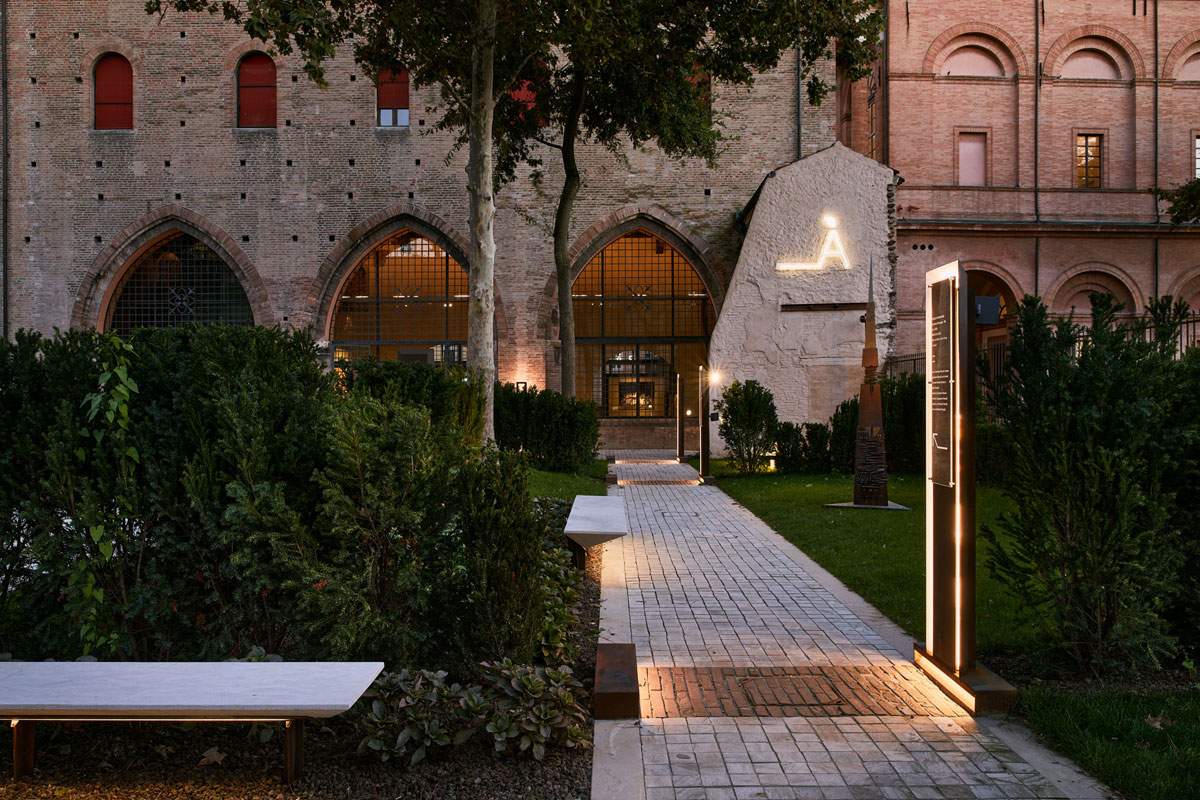From Arnaldo Pomodoro to Penone: Rimini, PART adds to Sculpture Garden
In Rimini, PART - Palazzi dell’Arte, the contemporary art museum born in 2020 (read the interview with curatorial coordinator Clarice Pecori Giraldi here), has since yesterday a new outdoor section, with an unprecedented outdoor musealization project and a new body of contemporary artworks linked to the San Patrignano Collection. The museum complex of PART - Palazzi dell’Arte, born from the collaboration between the Municipality of Rimini and the San Patrignano Collection, thus makes the collaboration between public and private continue in the fulfillment in the opening to the public of the Rimini Sculpture Garden, an open-air section of the museum, which integrates the proposal of PART with an outdoor public space dedicated to the art of our time.
Conceived as an extension of PART’s exhibition itinerary, opened in September 2020, the Garden, which will always be accessible free of charge, transforms the public area that historically belonged to the municipal bakery into a marriage of contemporary art and nature. The museographic project takes its starting point from the idea of enhancing historical memory by recalling with shrubby green walls the ancient floor plan of the Rimini city bakery, which existed until 1898 and of which some visible elements remain. Within the vegetated perimeter, which interprets a current version of the typical Italian garden and evokes the idea of ruin in the interweaving of masonry and natural components, the visitor discovers a selection of seven contemporary art sculptures, set up in open-air “exhibition rooms.”
Following a fluid and unfettered path that extends the PART experience outside the museum walls, the Garden aims to create a new opportunity to relate to art in thoughtful corners surrounded by greenery. The seven sculptures that inhabit the Garden are evidence of shared participation alongside San Patrignano: they are works that have been donated to the San Patrignano Collection, on loan from galleries and on loan from international artists, as well as site-specific installations, as in the case of Paul Kneale ’s work that, soaring more than three meters high among the vegetation, almost looks like a particular species of tree. The dog portrayed here belongs to one of Trivero’s families. This work is dedicated to them and to the people who sitting here will talk about them (2009), a work by Alberto Garutti donated by the artist himself to the San Patrignano Collection, is literally what the title describes: a concrete and galvanized iron bench with a dog sitting on one side. Anatomy by Giuseppe Penone (2011) is composed of a block of white Carrara marble from which sprout roots and branches of trees that seem to live embedded in time: the work is lent by the artist and given on loan for use by the Gagosian gallery. A gift from Daniele Pescali and Anna Cappanera Pescali in memory of Daniele Pescali Senior and Gianni Pescali, is Lance of Light I (1985) made in bronze by Arnaldo Pomodoro, a work that points toward infinity and hints at a cosmic journey, as does Kiki Smith’s sculpture, also in bronze, Stella I (2013), sponsored by Lorcan O’Neill Gallery. Polish artist Piotr Uklanski, represented by MASSIMODECARLO, participates with a large-scale installation in steel tubing and paint, Untitled (The Thing) (2007), which draws the outline of an open hand that appears to grasp the surrounding landscape. The work on loan by Chinese artist Chen Zhen is set up to recompose a “garden within a garden,” a metaphor for a lost beauty, by installing five bronze and metal slabs whose reliefs depict the history of the Qianlong Emperor’s park built in the mid-eighteenth century; the work is entitled Jardin mémorable (2000) and is given on loan for use by the Continua Gallery.
The museographic project, conceived and implemented by Luca Cipelletti’s Studio AR.CH.IT together with the lighting design by Alberto Pasetti Bombardella’s Studio Pasetti Lighting, who had already signed the functional redevelopment project and the installation of PART, is inspired by the planimetric division of the kiln that favors the contemplation of the sculptures and makes the Garden capable of also hosting events, demonstrations and meetings, as well as permanent and temporary exhibitions. The area covers an area of 1,675 square meters and is characterized by a stretch of water placed in axis with the meeting point between the Palazzo dell’Arengo and the Palazzo del Podestà. The walkway is composed of San Marino stone cubes and solid terracotta bricks, and is scanned in different rooms to accommodate the sculptures. The spaces include benches, whose angular structure generates continuity with the structures of the architectural environment inside PART, and the planting of 345 yew hedges and new trees, thus increasing the share of vertical greenery. The opening of the Sculpture Garden represents a continuous consecration of a lively path born from an intuition that reinvents the relationship between public and private social, with the aim of giving rise to a virtuous system that brings benefits to the individual, the city, the territory and thus the community.
 |
| From Arnaldo Pomodoro to Penone: Rimini, PART adds to Sculpture Garden |
Warning: the translation into English of the original Italian article was created using automatic tools. We undertake to review all articles, but we do not guarantee the total absence of inaccuracies in the translation due to the program. You can find the original by clicking on the ITA button. If you find any mistake,please contact us.



























